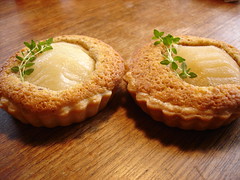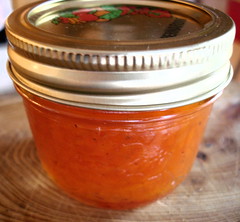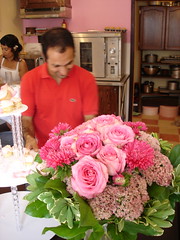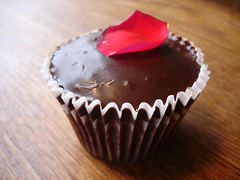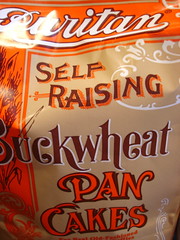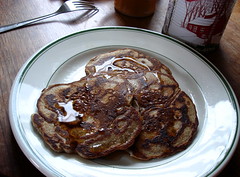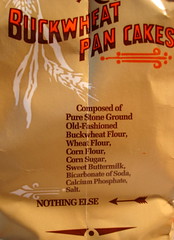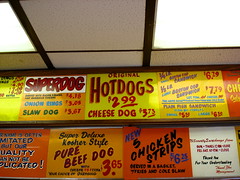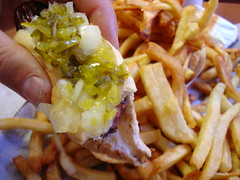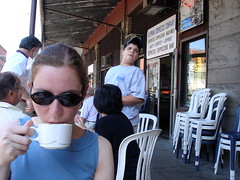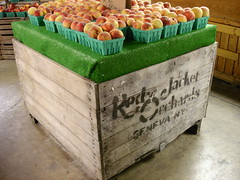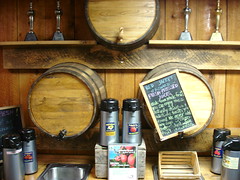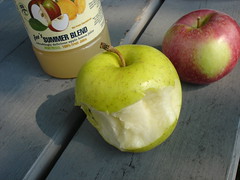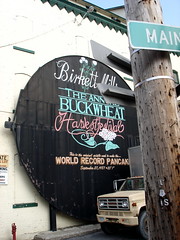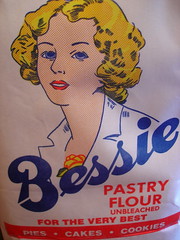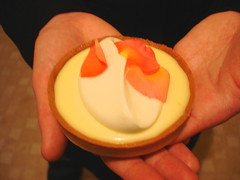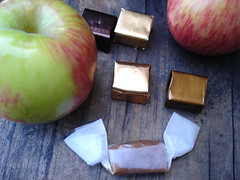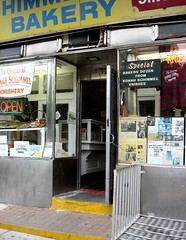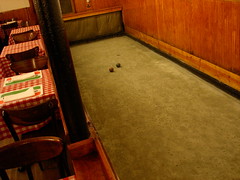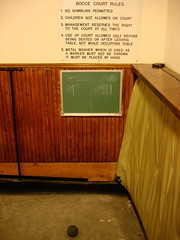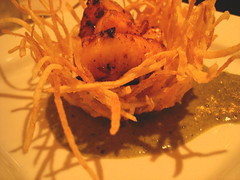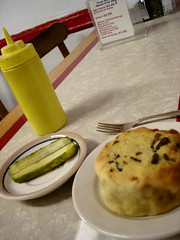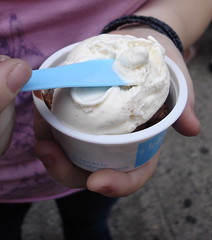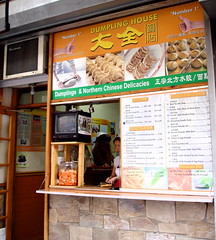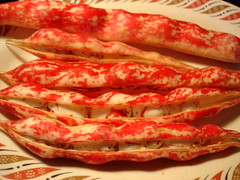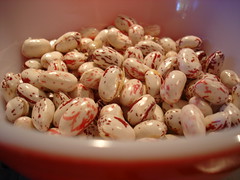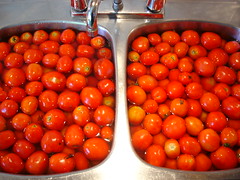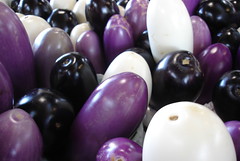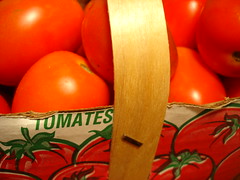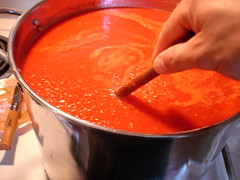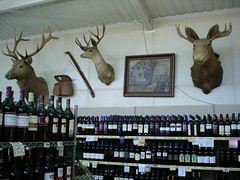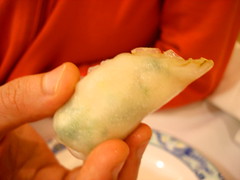Coast to coast, San Francisco to New York, in just a matter of weeks? Don’t get too excited. We haven’t become one of those unbelievably jet-set food blogs yet (although we are just about to head off to Pittsburgh for the weekend in search of a wedding, an "O dog," and Slovak
pirohy). Truth be told, we made it back from our Bay Area vacation and I had the opportunity to housesit a friend’s place in Queens for a week or so, and I really needed to spend some time in New York in order to do some non-food related research. That’s it. That’s all there is to the story. New York being New York, though, I was damned if I wasn’t going to sneak in a bit of culinary research “after hours.” As you’ll see, this time around my food tourism was concentrated on the Upper East Side and the Lower East Side, two districts that used to be diametric opposites, but are rapidly becoming more and more alike (especially if one remembers that the Upper East Side, too, had a past as a notorious home to ethnic enclaves of all stripes).
Il Vagabondo
R & M took me here a few years back when I was in town for a weekend on my way back to Montreal from Europe and points east. I remember it was early August and it was hot as sin and at one point during that visit I had a cabdriver who said he’d immigrated to New York from Puerto Rico some 25 years earlier, and he’d always toughed it out and managed to get through those steamy New York summers without an air conditioner (he was from Puerto Rico, after all), but that that summer (it must have been 1999) had finally broken him. He’d caved in and bought himself his first window unit. I thought of that cabdriver this time around. I just missed the 100+ weather that hit the region earlier in the month, but it was still awfully muggy as I made my way around town, and the air caught in the subway made the tunnels feel like furnace rooms. Anyway, like I said, I celebrated my August in New York with a trip to Il Vagabondo, and I was really excited about it because I’ve been telling stories about this place for years now: apocryphal tales about Il Vagabondo’s status as a haunt of the disco glitterati during the late ‘70s, firsthand accounts of the excellent Italian food they serve up, but especially stories about the bocce ball court housed
inside the restaurant. This was no cheap gimmick, either. Apparently, the restaurant had been built around a pre-existing bocce ball court; this place was almost as serious about its bocce ball it was about its food (if you don't believe me, check out the list of rules and regulations above). Well, the bocce ball court is still there and Il Vagabondo still makes delicious food. We had a nice bottle of Sangiovese, a truly enormous spread that included Caesar Salad, pasta as our
primi piatti, and a selection of their meat dishes, including what R considers to be the definitive "veal Parm," and an excellent chicken cooked in a wine sauce and served with sausages. I hadn’t seen R & M in a while; we watched the action on the bocce court and caught up.
Khyber Grill
A few nights later I hooked up with R & M again and they took me to their favorite Indian restaurant of the moment. We postponed our visit until the Sunday night because the
maître d’hotel had been away on vacation back in India and was due back in that weekend. As valued regulars, R & M receive VIP treatment when they pay a visit to Khyber Grill, and the
maître d’ is apparently particularly attentive, not to mention a true character. Unfortunately, the man we’d come to see in action was still away, but we still got treated like royalty. Khyber Grill specializes in New Indian the likes of which we’ve yet to see in Montreal. It’s a first-class establishment: the dining room is plushly appointed, there’s a nice bar at the front of the restaurant, the kitchen is state of the art and open to view, and the chef who mans it has put together a menu that is very interesting indeed. The best appetizer we had was a Goan pan-seared scallops dish served in a potato nest and adorned with a mint and coriander chutney. Michelle had the opportunity to go to India on a business trip a couple of years ago and came back raving about the Goan fish dishes she’d had; I wasn’t about to pass up the opportunity to try some Goan scallops. The scallops themselves were heavenly, my only quibble was that the nest wasn’t nearly as tasty (or as edible, for that matter) as it should have been. Our mains included a delicious Chicken Vindaloo, a fantastic Spinach Kofte dish, and some wonderfully buttery black lentils. There’s a reason people are crazy about this place. It may not have received the hype that some of the city’s other New Indian restaurants have, but Khyber Grill's kitchen is outstanding, and that's all that really matters.
Yonah Schimmel’s
A year and a half ago (March 4, 2004, to be exact, according to my notebook), Michelle and I spent a day doing a nosher’s walking tour of the Lower East Side, where we hit everything from old classics like Kossar’s (which we found wasn’t living up to its past glories), Russ and Daughters, and Gus’s Pickles, to newbies like the Doughnut Plant. One of our main stops along this pilgrimage of sorts was Yonah Schimmel’s knishery. I was working not far from the knishery this time around, and I liked Yonah Schimmel’s knishes so much the last time, I made a point of going back for another one of their mushroom-potato beauts. I was sad to see that the price on their old-fashioned egg creams seemed to have shot up, but nothing else seemed to have changed too much (it's definitely one of those time-warp establishments, like Wilensky's here in Montreal), and their knishes are still just as tasty and filling as ever.
Il Laboratorio del Gelato
My last day in town was a Sunday, and the temperature had really started to creep up again. Earlier that day I’d been reading my friend J’s 2004 special edition of
The Art of Eating on New York City, and I came across a write-up on Il Laboratorio. I remembered that M had told me about their gelatos and how good they are just a few days earlier, and with things shaping up for a steamy afternoon, I made a mental note to try and find their storefront. Il Laboratorio is yet another one of the slick new restaurants, bars, galleries, and retail spaces that have utterly transformed the Lower East Side. In the case of Il Laboratorio, its part in this transformation is particularly stark: it’s right next to the Lower East Side Tenement Museum, on a block that just over a decade ago was still very much a part of the district’s archaic garment district. H and I got there just before closing time and ordered a small cup to split, opting for a chocolate and vanilla combo to see how Il Laboratorio handled the basics. The verdict: pricey, but excellent. It went down easy on a muggy Sunday afternoon.
#1 Dumpling House
Since we discovered #1 Dumpling House purely by accident a few years back, I’ve found it impossible to go to New York without paying them a visit. We were just wandering around Chinatown one night, grabbing snacks here and there, when we passed #1 Dumpling House and decided to give them a try (back then they didn't have the flashy facade/awning combo that they've got now). We ordered dumplings, naturally, and they were very good and very cheap (although not as cheap as the 99¢ place just down the street), but then we started to see some other interesting dishes pass by. We studied other people’s orders, asked a few questions, and then ended up with our first “sesame pancake with beef.” Thinly sliced beef, garnished with marinated vegetables and fresh coriander, and stuffed inside a freshly steamed sesame encrusted pancake—in terms of short order “street food,” it really doesn’t get much better than this (and each sandwich will only set you back $1.50!). If you look very closely at the picture above, you’ll see a
New York Times article about Marcella Hazan and her passion for #1 Dumpling House. You see, we’re not the only ones who go nuts over #1 Dumpling House and their northern Chinese delicacies.
How’s that for an eclectic list?
Il Vagabondo, 351 East 62nd St., New York City, (212) 832-9221
Khyber Grill, 230 East 58th St., New York City, (212) 339-0090
Yonah Schimmel’s Knishery, 137 East Houston St., New York City, (212) 477-2858
Il Laboratorio del Gelato, 95 Orchard St., New York City, (212) 343-9922
#1 Dumpling House, 118 Eldridge St., New York City, (212) 625-8008
aj
*(doesn't quite have the same ring as "Paris in April," but then it's a lot more fun than "August in Paris")
